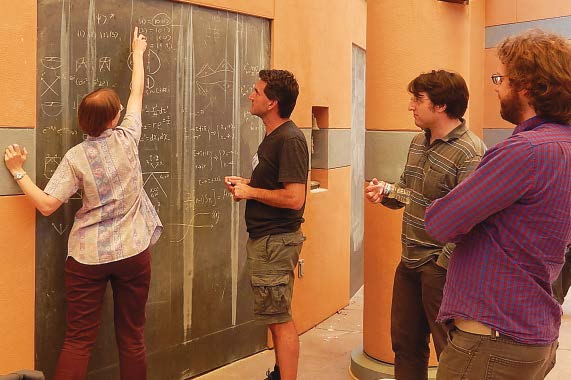 Visiting physicists debating entanglement.
Visiting physicists debating entanglement.
This spring, an eclectic group of physicists descended upon the KITP. Representing fields as far-flung as string theory, quantum computing, cold atoms, and condensed-matter experiment, many of these scientists had never imagined gathering together. Yet, a common interest drew them to participate in a program about “entanglement”, a topic that has come to lie at the center of quantum physics and technology in the 21st century.
To understand the excitement, we must take a step back and consider that enigmatic wisp of quantum fluff that brought these physicists together. Entanglement is the quantum tie that binds particles across space and time. It occurs when two particles are so closely linked that they essentially share the same reality. For example, particles that are created together can be strongly entangled, allowing one to immediately influence another at some later time, even across a vast distance. This violation of locality — a causal influence at speeds faster than light — so irked Einstein that he famously dismissed entanglement as “spooky action at a distance.”
Since those early days of quantum mechanics, entanglement has evolved from a pesky quirk, to an inescapable reality, to its modern role as a powerful resource, providing ways to perform otherwise impossible tasks (such as unbreakable cryptography, ultra-dense data compression, and more). This resource-based view of entanglement is at the root of the modern theory of quantum information science, with the goal (among other things) of nothing less than the construction of the next generation of computers. The algorithms potentially provided by quantum computers include the efficient factorization of large prime numbers — thus effectively breaking the public-key encryption used to secure the world’s communication systems. Accordingly, in the last decade there has been an explosion of research on them by our largest institutions; government, military, academic, and information-industrial alike — many with deep ties to UC Santa Barbara.
As evident on KITP’s blackboards, a quieter but no less startling revolution is growing in the ranks of theoretical physics, promising a new type of unification of disparate fields under the common (if unfamiliar) guise of entanglement. This union can trace its origins to the observation that most theories of quantum particles in a volume of space, surprisingly, have an entanglement structure that can be encoded on a lower-dimensional boundary. Recently, string theorists led by Maldacena discovered a firm mathematical underpinning to this relationship, conjecturing that the natural curvature inherent in geometric descriptions of gravity can encode quantum mechanics in one lower dimension. This astonishing link suggests a deep “holographic” duality between gravity and quantum theory, that compelled many an excited physicist to stay at work late at KITP, reevaluating their old dreams of a unified theory of quantum gravity in a new light.
The holographic duality of entanglement was a focal point of this program. It served as a conceptual pivot, around which a relativist might propose a calculation to a computational physicist; or, a theorist working on high-energy particles could frame an idea to her low-energy condensed-matter counterpart. In some cases, the duality makes striking connections; for example, between entanglement in a microscopic model of electrons on a lattice, and the geometrical structure of a classical gravity theory. Most remarkably, since such models apply to real matter and materials at extremely low temperatures, this connection is not restricted to the realm of theory. As the centerpiece of the program, a handful of talks by experimentalists showed, for the first time, how entanglement can be detected in real measurements on delicate crystals of atoms, held in quantum states near absolute zero.
From this springs the optimism that the new common language of entanglement may someday soon provide predictions for table-top experiments in the laboratory, ushering in new tests of our deepest theories of quantum mechanics, space, and time. More practically, these seemingly abstract theories are birthing a powerful paradigm for quantum matter, which promises, for example, to employ entanglement to identify exotic quantum states, such as the so-called topological phases. As pioneering work right here at UCSB has shown, these topological phases may be our best candidates for the building blocks of future quantum computers.
It seems remarkable that the first technological application of the union of information theory, gravity, and condensed-matter physics might be the next stage of evolution of humankind’s artificial thinking machines. Yet other, less tangible, consequences of this new synergy are still unfolding in workshops like that recently held at the KITP, where physicists of every creed and guild can find a common language to share their ideas with one another. On what other paths of discovery this new theoretical structure will lead us is uncertain, but this much is clear: the bridge between fields, built by entanglement, is with us to stay.
Roger Melko, Professor, University of Waterloo, and Perimeter Institute, was in residence as a Program Coordinator in spring 2015.
KITP Newsletter, Fall 2015
